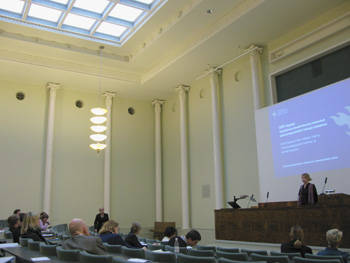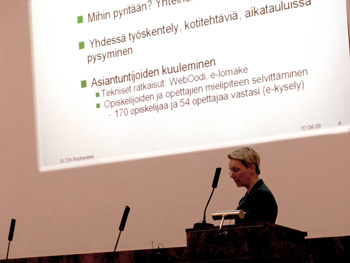 One of my duties as an e-learning planner is working on the faculty’s feedback system, especially the part concerning electronic means of collecting and storing student course feedback (which we collect mostly with e-lomake). The plan for the next strategic period of the university (2010-2012) has collecting feedback as one of its points of focus, making the task of having a working feedback system even more fitting, and this event I attended was part of the preliminary university-wide look on how feedback currently has been organized at the university. Student representatives told their views on what they wanted from the feedback they gave after each course, and different feedback cases were presented, including Mia Ruohoniemi showing what we currently do at the Faculty of Veterinary Medicine.
One of my duties as an e-learning planner is working on the faculty’s feedback system, especially the part concerning electronic means of collecting and storing student course feedback (which we collect mostly with e-lomake). The plan for the next strategic period of the university (2010-2012) has collecting feedback as one of its points of focus, making the task of having a working feedback system even more fitting, and this event I attended was part of the preliminary university-wide look on how feedback currently has been organized at the university. Student representatives told their views on what they wanted from the feedback they gave after each course, and different feedback cases were presented, including Mia Ruohoniemi showing what we currently do at the Faculty of Veterinary Medicine.
Important stuff that came up and should be taken into account when discussing feedback:
- Counterfeedback: it is important to tell the students how the feedback was taken into account and how it will change the teaching in the future. Students often didn’t know what happened to feedback after it had been given.
- Transparency: Make the feedback results available when needed. A slight problem is what happens with course feedback after it has been used by the teachers – where does it go and how can someone who needs the info get it? Also, taking today’s stricter identity protection laws into account is important, and collecting feedback that might contain personally identifiable data needs to be done carefully.
- Taking criticism: Teachers need to be able to interpret the feedback results (often including straightforward negative comments) and be prepared for criticism so that it doesn’t cause unnecessary psychological distress. This might be a real problem for some people who aren’t used to it.
One attendant presented the view that feedback should be collected so that the student signs it with his/her own name, thus staying behind the words (and possibly be more reasonable and not use unnecessary vulgarities) . There can unfortunately be instances where non-anonymous feedback can be harmful to the student giving it, so it might not work as a general guideline (for example, vet students expressed their concerns about maintaining anonymity in a survey regarding feedback collecting in 2007). The tight ip-laws often demand that feedback has to be anonymous unless giving it is an integral part of the course.
 The electronic student administration service WebOodi has a feedback form component (PalauteOodi) integrated into its horribly dated interface, but we have used E-lomake instead because it is so much faster to work with. Still, having course enrollment and feedback after the course in one system would be great so it was nice to hear that First Vice Rector Hannele Niemi mentioned that the improvement of PalauteOodi would be on the to-do list.
The electronic student administration service WebOodi has a feedback form component (PalauteOodi) integrated into its horribly dated interface, but we have used E-lomake instead because it is so much faster to work with. Still, having course enrollment and feedback after the course in one system would be great so it was nice to hear that First Vice Rector Hannele Niemi mentioned that the improvement of PalauteOodi would be on the to-do list.
Now, I’m going to concentrate on the three points counted above. Of course there were many other things and good ideas presented at the meeting, but you have to start Somewhere to get There… and collect feedback on the way!
